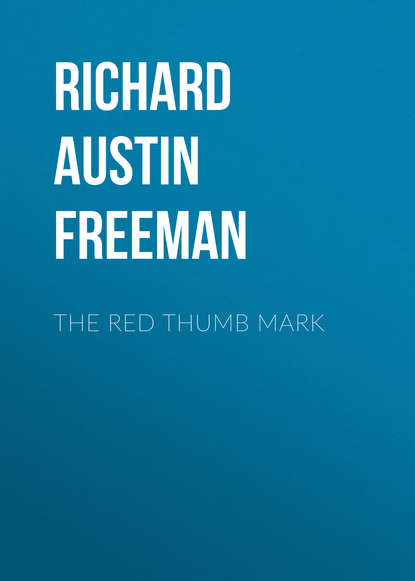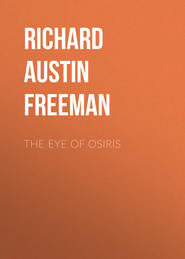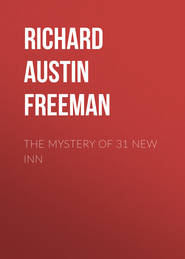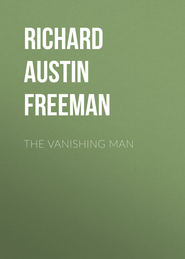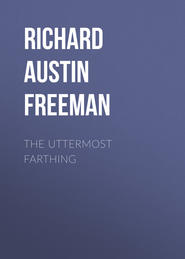По всем вопросам обращайтесь на: info@litportal.ru
(©) 2003-2024.
✖
The Red Thumb Mark
Настройки чтения
Размер шрифта
Высота строк
Поля
"That is an excellent plan," said the judge; "and, as the information is for myself and the jury, it would be better if you came up and performed the actual stamping on my table in the presence of the foreman of the jury and the counsel for the prosecution and defence."
In accordance with the judge's direction Thorndyke stepped up on the dais, and Anstey, as he rose to follow, leaned over towards me.
"You and Polton had better go up too," said he: "Thorndyke will want your assistance, and you may as well see the fun. I will explain to his lordship."
He ascended the stairs leading to the dais and addressed a few words to the judge, who glanced in our direction and nodded, whereupon we both gleefully followed our counsel, Polton carrying the box and beaming with delight.
The judge's table was provided with a shallow drawer which pulled out at the side and which accommodated the box comfortably, leaving the small table-top free for the papers. When the lid of the box was raised, there were displayed a copper inking-slab, a small roller and the twenty-four "pawns" which had so puzzled Polton, and on which he now gazed with a twinkle of amusement and triumph.
"Are those all stamps?" inquired the judge, glancing curiously at the array of turned-wood handles.
"They are all stamps, my lord," replied Thorndyke, "and each is taken from a different impression of the prisoner's thumb."
"But why so many?" asked the judge.
"I have multiplied them," answered Thorndyke, as he squeezed out a drop of finger-print ink on to the slab and proceeded to roll it out into a thin film, "to avoid the tell-tale uniformity of a single stamp. And I may say," he added, "that it is highly important that the experts should not be informed that more than one stamp has been used."
"Yes, I see that," said the judge. "You understand that, Sir Hector," he added, addressing the counsel, who bowed stiffly, clearly regarding the entire proceeding with extreme disfavour.
Thorndyke now inked one of the stamps and handed it to the judge, who examined it curiously and then pressed it on a piece of waste paper, on which there immediately appeared a very distinct impression of a human thumb.
"Marvellous!" he exclaimed. "Most ingenious! Too ingenious!" He chuckled softly and added, as he handed the stamp and the paper to the foreman of the jury: "It is well, Dr. Thorndyke, that you are on the side of law and order, for I am afraid that, if you were on the other side, you would be one too many for the police. Now, if you are ready, we will proceed. Will you, please, stamp an impression in square number three."
Thorndyke drew a stamp from its compartment, inked it on the slab, and pressed it neatly on the square indicated, leaving there a sharp, clear thumb-print.
The process was repeated on nine other squares, a different stamp being used for each impression. The judge then marked the ten corresponding squares of the other two sheets of paper, and having checked them, directed the foreman to exhibit the sheet bearing the false thumb-prints to the jury, together with the marked sheet which they were to retain, to enable them to check the statements of the expert witnesses. When this was done, the prisoner was brought from the dock and stood beside the table. The judge looked with a curious and not unkindly interest at the handsome, manly fellow who stood charged with a crime so sordid and out of character with his appearance, and I felt, as I noted the look, that Reuben would, at least, be tried fairly on the evidence, without prejudice or even with some prepossession in his favour.
With the remaining part of the operation Thorndyke proceeded carefully and deliberately. The inking-slab was rolled afresh for each impression, and, after each, the thumb was cleansed with petrol and thoroughly dried; and when the process was completed and the prisoner led back to the dock, the twenty squares on the paper were occupied by twenty thumb-prints, which, to my eye, at any rate, were identical in character.
The judge sat for near upon a minute poring over this singular document with an expression half-way between a frown and a smile. At length, when we had all returned to our places, he directed the usher to bring in the witnesses.
I was amused to observe the change that had come over the experts in the short interval. The confident smile, the triumphant air of laying down a trump card, had vanished, and the expression of both was one of anxiety, not unmixed with apprehension. As Mr. Singleton advanced hesitatingly to the table, I recalled the words that he had uttered in his room at Scotland Yard; evidently his scheme of the game that was to end in an easy checkmate, had not included the move that had just been made.
"Mr. Singleton," said the judge, "here is a paper on which there are twenty thumb-prints. Ten of them are genuine prints of the prisoner's left thumb and ten are forgeries. Please examine them and note down in writing which are the true prints and which are the forgeries. When you have made your notes the paper will be handed to Mr. Nash."
"Is there any objection to my using the photograph that I have with me for comparison, my lord?" asked Mr. Singleton.
"I think not," replied the judge. "What do you say, Mr. Anstey?"
"No objection whatever, my lord," answered Anstey.
Mr. Singleton accordingly drew from his pocket an enlarged photograph of the thumb-print and a magnifying glass, with the aid of which he explored the bewildering array of prints on the paper before him; and as he proceeded I remarked with satisfaction that his expression became more and more dubious and worried. From time to time he made an entry on a memorandum slip beside him, and, as the entries accumulated, his frown grew deeper and his aspect more puzzled and gloomy.
At length he sat up, and taking the memorandum slip in his hand, addressed the judge.
"I have finished my examination, my lord."
"Very well. Mr. Nash, will you kindly examine the paper and write down the results of your examination?"
"Oh! I wish they would make haste," whispered Juliet. "Do you think they will be able to tell the real from the false thumb-prints?"
"I can't say," I replied; "but we shall soon know. They looked all alike to me."
Mr. Nash made his examination with exasperating deliberateness, and preserved throughout an air of stolid attention; but at length he, too, completed his notes and handed the paper back to the usher.
"Now, Mr. Singleton," said the judge, "let us hear your conclusions. You have been sworn."
Mr. Singleton stepped into the witness-box, and, laying his notes on the ledge, faced the judge.
"Have you examined the paper that was handed to you?" asked Sir Hector Trumpler.
"I have."
"What did you see on the paper?"
"I saw twenty thumb-prints, of which some were evident forgeries, some were evidently genuine, and some were doubtful."
"Taking the thumb-prints seriatim, what have you noted about them?"
Mr. Singleton examined his notes and replied—"The thumb-print on square one is evidently a forgery, as is also number two, though it is a passable imitation. Three and four are genuine; five is an obvious forgery. Six is a genuine thumb-print; seven is a forgery, though a good one; eight is genuine; nine is, I think, a forgery, though it is a remarkably good imitation. Ten and eleven are genuine thumb-marks; twelve and thirteen are forgeries; but as to fourteen I am very doubtful, though I am inclined to regard it as a forgery. Fifteen is genuine, and I think sixteen is also; but I will not swear to it. Seventeen is certainly genuine Eighteen and nineteen I am rather doubtful about, but I am disposed to consider them both forgeries. Twenty is certainly a genuine thumb-print."
As Mr. Singleton's evidence proceeded, a look of surprise began to make its appearance on the judge's face, while the jury glanced from the witness to the notes before them and from their notes to one another in undisguised astonishment.
As to Sir Hector Trumpler, that luminary of British jurisprudence was evidently completely fogged; for, as statement followed statement, he pursed up his lips and his broad, red face became overshadowed by an expression of utter bewilderment.
For a few seconds he stared blankly at his witness and then dropped on to his seat with a thump that shook the court.
"You have no doubt," said Anstey, "as to the correctness of your conclusions? For instance, you are quite sure that the prints one and two are forgeries?"
"I have no doubt."
"You swear that those two prints are forgeries?"
Mr. Singleton hesitated for a moment. He had been watching the judge and the jury and had apparently misinterpreted their surprise, assuming it to be due to his own remarkable powers of discrimination; and his confidence had revived accordingly.
"Yes," he answered; "I swear that they are forgeries."
Anstey sat down, and Mr. Singleton, having passed his notes up to the judge, retired from the box, giving place to his colleague.
Mr. Nash, who had listened with manifest satisfaction to the evidence, stepped into the box with all his original confidence restored. His selection of the true and the false thumb-prints was practically identical with that of Mr. Singleton, and his knowledge of this fact led him to state his conclusions with an air that was authoritative and even dogmatic.
"I am quite satisfied of the correctness of my statements," he said, in reply to Anstey's question, "and I am prepared to swear, and do swear, that those thumb-prints which I have stated to be forgeries, are forgeries, and that their detection presents no difficulty to an observer who has an expert acquaintance with finger-prints."
"There is one question that I should like to ask," said the judge, when the expert had left the box and Thorndyke had re-entered it to continue his evidence. "The conclusions of the expert witnesses—manifestly bona fide conclusions, arrived at by individual judgement, without collusion or comparison of results—are practically identical. They are virtually in complete agreement. Now, the strange thing is this: their conclusions are wrong in every instance" (here I nearly laughed aloud, for, as I glanced at the two experts, the expression of smug satisfaction on their countenances changed with lightning rapidity to a ludicrous spasm of consternation); "not sometimes wrong and sometimes right, as would have been the case if they had made mere guesses, but wrong every time. When they are quite certain, they are quite wrong; and when they are doubtful, they incline to the wrong conclusion. This is a very strange coincidence, Dr. Thorndyke. Can you explain it?"
Thorndyke's face, which throughout the proceedings had been as expressionless as that of a wooden figurehead, now relaxed into a dry smile.
"I think I can, my lord," he replied. "The object of a forger in executing a forgery is to produce deception on those who shall examine the forgery."





